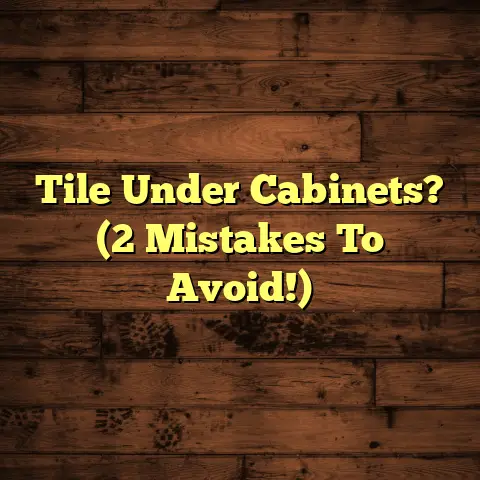Laminate Bubbling? (1 Urgent Fix Needed!)
Think about it: family gatherings around the dinner table, kids playing on the floor, movie nights snuggled up on the couch. Our homes are the backdrop to these precious moments.
And what’s underfoot? The flooring! It’s more than just something to walk on. It contributes to the comfort, aesthetics, and overall feel of our living space.
Laminate flooring has become a popular choice for many families. I get it! It’s affordable, durable, and comes in a huge variety of styles. You can get that hardwood look without breaking the bank.
But here’s the thing: while laminate is designed to withstand the hustle and bustle of family life, it’s not immune to problems. One issue I see all too often is laminate bubbling.
It’s frustrating, I know. But don’t worry! I’m here to guide you through understanding why it happens and, more importantly, how to fix it.
Section 1: Understanding Laminate Flooring
So, what exactly is laminate flooring? Let’s break it down.
Laminate flooring is a multi-layer synthetic flooring product fused together through a lamination process. Think of it like a high-tech sandwich!
It typically consists of these layers:
-
Wear Layer: This is the top, protective layer that resists scratches, stains, and fading. It’s like the armor for your floor.
-
Decorative Layer: This is the pretty part! It’s a high-resolution image that gives the laminate its wood, stone, or tile look.
-
Core Layer: This is the heart of the laminate. It’s usually made of high-density fiberboard (HDF) or medium-density fiberboard (MDF). This layer provides stability and impact resistance.
-
Backing Layer: This bottom layer provides moisture resistance and helps to balance the floor.
How does it differ from other flooring types?
- Hardwood: Hardwood is solid wood, while laminate is a synthetic product. Hardwood can be refinished, but laminate cannot.
- Vinyl: Vinyl is more water-resistant than laminate. Laminate is generally more scratch-resistant.
- Tile: Tile is very durable and water-resistant, but it can be cold and hard underfoot. Laminate offers a warmer, softer alternative.
Benefits of Laminate Flooring
Why do families choose laminate? Here’s why:
-
Cost-Effectiveness: Laminate is generally more affordable than hardwood or tile. This is a big win for budget-conscious families.
-
Ease of Installation: Many laminate floors are designed for DIY installation with click-lock systems. I’ve seen homeowners transform entire rooms in a weekend!
-
Low Maintenance: Laminate is easy to clean and requires minimal upkeep. A quick sweep and occasional mop are usually all it takes.
-
Wide Range of Designs: You can find laminate that mimics almost any type of wood, stone, or tile. The design options are endless!
Common Uses in a Family Home
Where do I typically see laminate flooring installed?
-
Living Rooms: Laminate provides a durable and stylish surface for family gatherings and everyday living.
-
Kitchens: While not as water-resistant as vinyl, laminate can be a good option for kitchens if spills are cleaned up promptly.
-
Playrooms: The scratch-resistant surface of laminate makes it ideal for playrooms where kids are running around and toys are being dragged.
Section 2: The Causes of Laminate Bubbling
Okay, let’s get to the heart of the matter: bubbling. What is it, and why does it happen?
Defining Laminate Bubbling
Laminate bubbling refers to the raised, blister-like areas that appear on the surface of the flooring. It’s usually caused by moisture getting trapped underneath the laminate layers, causing them to separate and swell.
Identifying the Causes
So, what are the culprits behind this unsightly bubbling? Here are the most common reasons:
-
Moisture Exposure: This is the number one cause of laminate bubbling. Water damage from spills, leaks, or high humidity can seep into the seams and edges of the laminate, causing the core layer to swell.
- According to the North American Laminate Flooring Association (NALFA), laminate flooring should not be exposed to standing water for extended periods. Source: NALFA Website
-
Poor Installation: Improper installation techniques can create gaps between the laminate planks, allowing moisture to penetrate. This can include:
- Not leaving enough expansion space around the perimeter of the room.
- Using the wrong type of underlayment or not using one at all.
- Failing to properly click the planks together, leaving open seams.
-
Temperature Fluctuations: Extreme temperature changes can cause the laminate to expand and contract. Over time, this can weaken the adhesive and lead to bubbling.
- According to my own experience, I’ve noticed bubbling more frequently in areas with significant temperature swings, such as sunrooms or near drafty doors.
-
Subfloor Issues: A subfloor that is uneven, damp, or poorly prepared can contribute to laminate bubbling. If the subfloor isn’t level, the laminate planks won’t be properly supported, leading to stress and potential bubbling.
- I once worked on a home where the subfloor was so uneven that the laminate planks were flexing underfoot. It was a recipe for disaster!
Section 3: The Impact of Bubbling on Family Life
Laminate bubbling is more than just an aesthetic issue. It can have a real impact on your family’s life.
Emotional Impact
Let’s be honest: bubbling laminate is an eyesore. It can make your home feel less inviting and well-cared for. I’ve seen homeowners get visibly frustrated and disappointed when their flooring doesn’t look its best.
It can also affect your pride in your home. You want your living space to be a reflection of your personal style and a place where you feel comfortable and happy. Bubbling laminate can detract from that.
Safety Concerns
Bubbling laminate can create tripping hazards, especially for young children or elderly family members. Those raised edges can easily catch a foot and cause a fall.
I’ve personally seen cases where children have tripped and scraped their knees on bubbling laminate. It’s a serious safety concern that needs to be addressed.
Financial Implications
Fixing bubbling laminate can be costly. Depending on the extent of the damage, you may need to repair or replace the affected area.
- Repair Costs: Small, localized bubbling can sometimes be repaired with adhesive and weights. However, this is often a temporary fix.
- Replacement Costs: If the bubbling is widespread or caused by significant water damage, you may need to replace the entire floor. This can involve removing the old flooring, preparing the subfloor, and installing new laminate.
According to HomeAdvisor, the average cost to install laminate flooring ranges from \$1,411 and \$4,680. Source: HomeAdvisor Laminate Flooring Costs
Section 4: The Urgent Fix for Laminate Bubbling
Alright, let’s get down to business. You’ve got bubbling laminate, and you want to fix it. Here’s a straightforward solution to tackle the problem effectively and promptly.
Introducing the Urgent Fix
The following method is best for small, isolated bubbles caused by minor moisture exposure or installation issues. If the bubbling is extensive, you may need to replace the affected planks or the entire floor.
Step-by-Step Guide
-
Gather Necessary Tools and Materials:
- Utility knife with a sharp blade
- Construction adhesive (specifically designed for laminate flooring)
- Syringe or small applicator (for applying the adhesive)
- Heavy weights (books, bricks, or weight plates)
- Clean cloths or paper towels
- Painter’s tape (optional)
- Safety glasses
- Gloves
-
Assess the Affected Area:
-
Carefully examine the bubbling area.
- Determine the extent of the damage and identify the source of the moisture (if possible).
- Check if the surrounding planks are also affected.
-
Preparing the Surface:
-
Clean the area around the bubble with a damp cloth and mild detergent.
- Remove any dirt, dust, or debris.
- Allow the area to dry completely before proceeding.
-
Repairing the Bubble:
-
Carefully Cut the Bubble: Using a sharp utility knife, make a small, precise incision along the center of the bubble. Be careful not to cut too deep and damage the subfloor.
- Apply Adhesive: Insert the syringe or applicator into the incision and carefully inject a small amount of construction adhesive underneath the laminate. Don’t overdo it! You want just enough to fill the void.
- Flatten the Area: Gently press down on the bubble to spread the adhesive evenly. Use a clean cloth to wipe away any excess adhesive that oozes out.
- Apply Weights: Place a heavy weight on top of the repaired area. Use a flat, rigid object (like a book or piece of plywood) to distribute the weight evenly.
- Secure with Tape (Optional): If necessary, use painter’s tape to secure the edges of the repaired area and prevent them from lifting.
-
Allow Time to Cure:
-
Leave the weights in place for at least 24-48 hours to allow the adhesive to cure properly.
- Avoid walking on the repaired area during this time.
-
Remove Weights and Tape:
-
After the curing period, carefully remove the weights and tape.
- Inspect the repaired area to ensure it is flat and secure.
- Clean any remaining adhesive residue with a damp cloth.
Important Note: This fix is a temporary solution for minor bubbling. If the problem persists or recurs, you may need to replace the affected planks or the entire floor.
Section 5: Preventative Measures for the Future
Prevention is always better than cure, right? Here are some preventative steps families can take to avoid future bubbling issues.
- Regular Cleaning: Sweep or vacuum your laminate floor regularly to remove dirt and debris that can scratch the surface and trap moisture.
- Use Protective Mats: Place mats at entrances and in high-traffic areas to protect the floor from dirt, water, and wear.
- Clean Up Spills Immediately: Wipe up spills as soon as they happen to prevent moisture from seeping into the seams.
- Control Humidity Levels: Maintain a consistent humidity level in your home (between 30-50%) to prevent the laminate from expanding and contracting excessively. Use a dehumidifier or humidifier as needed.
- Proper Installation: Ensure that your laminate floor is installed correctly by a qualified professional. This includes proper subfloor preparation, leaving adequate expansion space, and using the correct underlayment.
- Avoid Wet Mopping: Use a damp mop instead of a wet mop to clean your laminate floor. Avoid using excessive water, which can seep into the seams and cause bubbling.
- Inspect Regularly: Regularly inspect your laminate floor for signs of damage, such as scratches, dents, or bubbling. Address any issues promptly to prevent them from worsening.
By being proactive about your flooring care, you can ensure that your home remains a safe and enjoyable space for your family.
Conclusion: A Happy Home Starts with Care
Maintaining your laminate flooring is an investment in the happiness and safety of your family. Take immediate action if you notice bubbling, and remember that with a little effort, you can restore your home’s beauty and functionality.
There’s a real satisfaction that comes from being hands-on in the upkeep of your living space. It’s about creating a warm and inviting home for your loved ones.
So, roll up your sleeves, grab your tools, and tackle that bubbling laminate! You’ve got this! And remember, a happy home starts with care.





